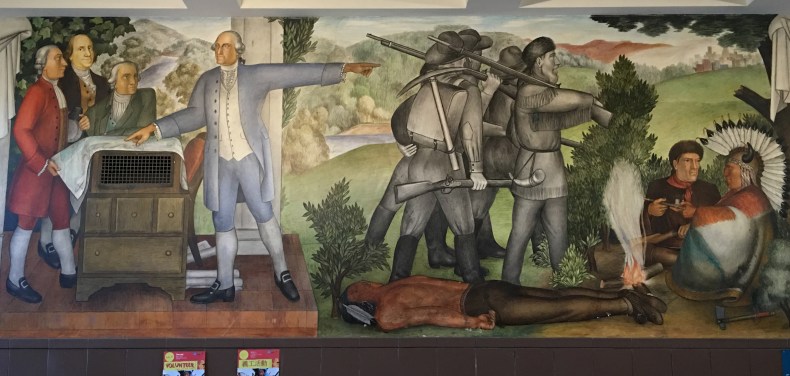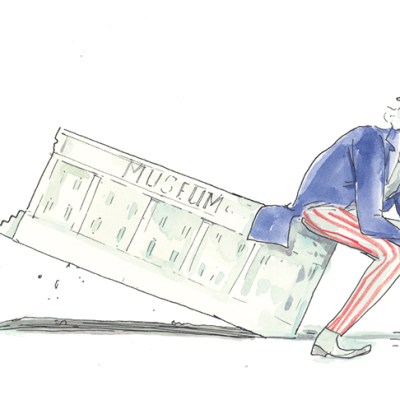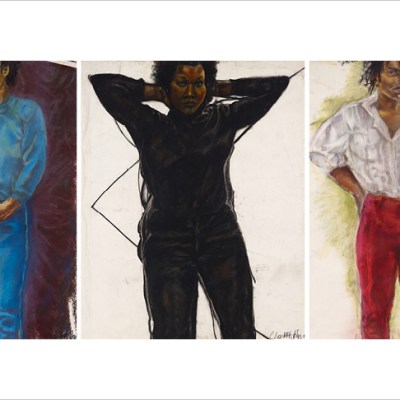At the height of the Great Depression, a Russian artist was paid by the US government to paint a series of murals in a San Francisco high school. The 1,600-square-foot, 13-panel work that Victor Arnautoff created was called The Life of Washington, after the school’s namesake. It could have embraced a hagiographical view of America’s founding father and first president: young Washington chopping down the cherry tree and saying ‘I cannot tell a lie’; old Washington relinquishing the role of president to avoid a return to monarchy. Yet Arnautoff chose a different approach, depicting Washington stripped of myth. The murals portray him as a slave owner and the progenitor of government policies that would result in the genocide of Native Americans.
The Washington murals are currently at the centre of a nationwide debate about public artistic depictions of American history. Earlier this year a group convened by the San Francisco Unified School District (SFUSD), which included current and former students at George Washington High School as well as local activists, artists and historians, registered their desire to get rid of the murals. They cited imagery depicting white frontiersmen stepping on the corpse of a Native American and enslaved African Americans working the fields of Washington’s estate, Mount Vernon. In June the city’s school board sided with those who wanted the murals removed, voting to paint over them. This decision prompted a strong response from those who felt that this was tantamount to censorship. Hollywood actor Danny Glover, an alumnus of the school, even weighed in, telling a local news station that ‘To destroy [the murals] or block them from view would be akin to book burning. We would be missing the opportunity for enhanced historic introspection this moment has provided us.’
Detail from Victor Arnautoff’s The Life of Washington mural at George Washington High School in San Francisco. Photo: courtesy Tammy Aramian/GWHS Alumni Association

The most recent turn in the controversy saw the school board vote only to cover the murals with panels rather than paint over them entirely. In other American cities, similar crises have emerged over racist public art that has been altered or removed, including a sculpture at Yale University in which a Puritan was shown pointing a gun at a Native American and a statue called Early Days in San Francisco that depicted a Native American kneeling beneath a Spanish vaquero. The debates also touch on the political uproar surrounding Confederate monuments, with some cities choosing to remove them or add contextualising materials – and, in others, activists taking it upon themselves to topple the statues. These controversies have highlighted difficult questions about public art: should art that represents values that are no longer accepted be destroyed, or should an effort be made to put it into context? Does this contextualisation allow viewers to say ‘things were different then’ and safely believe that the past’s racism and violence has nothing to do with the present? Does the artist’s intent matter? In the case of Confederate monuments, historians have painstakingly traced the sentiments and funds behind their erection to a profoundly racist, white supremacist intent.
Detail from Victor Arnautoff’s The Life of Washington mural at George Washington High School in San Francisco. Photo: courtesy Tammy Aramian/GWHS Alumni Association

What seems different about the Washington murals is that Arnautoff genuinely intended to condemn the legacy of white supremacy that undergirds American history. The panel that depicts the dead Native American indicts the white settlers committing the murder by depicting them in ghostly hues of grey and white; the Native American, who faces away from the viewer, is rendered in full colour, an enfleshed victim of the greed and prejudice of his colonisers. The direct connection between the policies of the founding fathers and Indian genocide is made obvious by Arnautoff’s placement of George Washington in the panel. His right hand points to a map and his left to the ghostly white settlers, as in the panel’s background forests give way to cities. In the 1930s, Arnautoff knew exactly the way this story of ‘manifest destiny’ was going to end. It is easy to understand how this haunting image might cause discomfort, but discomfort was precisely Arnautoff’s point.
Seen in this light, the work is invaluable for its decentring of George Washington from the story of his own life. Arnautoff’s focus on Native Americans, enslaved African Americans, and a rioting underclass overthrowing British tyranny provides a template for telling a different story of America’s foundations. And a public high school is the perfect location for this story to be told. An assignment contextualising the murals would allow students to consider the flawed lives of America’s founding fathers and the founding documents they wrote, alongside 1930s New Deal politics and the contemporary climate of polarisation in US politics. Students could be asked to think about the artistic choices of Arnautoff, an immigrant and Communist, and other muralists such as Diego Rivera, who were paid by Franklin Roosevelt’s Works Progress Administration and worked in San Francisco in the decade prior to the Second World War. They could explore the history of their own state, California, and how its founding was predicated on the eradication of Native Americans (a ‘genocide’ for which California governor Gavin Newsom formally apologised two months ago). This work of understanding American history is not easy – particularly for overburdened and underpaid public school teachers – but it is a vital education for teenagers who are already navigating the legacy of racist violence in their own lives. Public art that exposes these legacies should not be erased.



